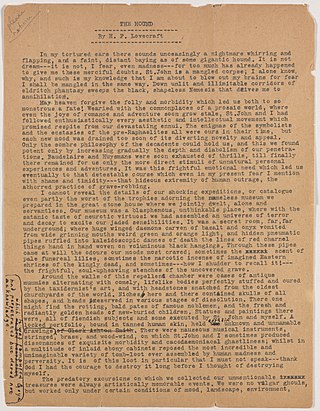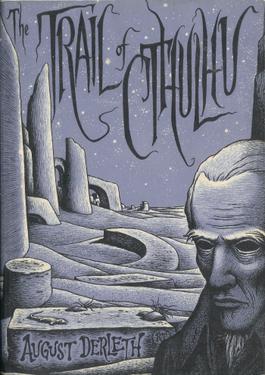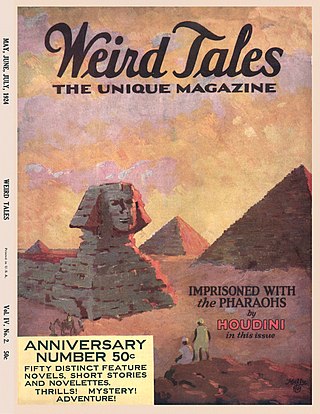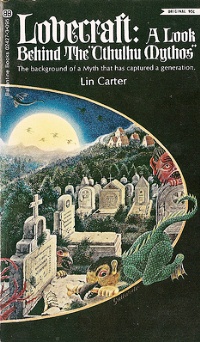
The Cthulhu Mythos is a mythopoeia and a shared fictional universe, originating in the works of Anglo-American horror writer H. P. Lovecraft. The term was coined by August Derleth, a contemporary correspondent and protégé of Lovecraft, to identify the settings, tropes, and lore that were employed by Lovecraft and his literary successors. The name "Cthulhu" derives from the central creature in Lovecraft's seminal short story "The Call of Cthulhu", first published in the pulp magazine Weird Tales in 1928.

The Necronomicon, also referred to as the Book of the Dead, or under a purported original Arabic title of Kitab al-Azif, is a fictional grimoire appearing in stories by the horror writer H. P. Lovecraft and his followers. It was first mentioned in Lovecraft's 1924 short story "The Hound", written in 1922, though its purported author, the "Mad Arab" Abdul Alhazred, had been quoted a year earlier in Lovecraft's "The Nameless City". Among other things, the work contains an account of the Old Ones, their history, and the means for summoning them.

Azathoth is a deity in the Cthulhu Mythos and Dream Cycle stories of writer H. P. Lovecraft and other authors. He is the supreme deity of the Cthulhu Mythos and the ruler of the Outer Gods, and may also be seen as a symbol for primordial chaos, therefore being the most powerful entity in the entirety of the Cthulhu Mythos.

Frank Belknap Long Jr. was an American writer of horror fiction, fantasy, science fiction, poetry, gothic romance, comic books, and non-fiction. Though his writing career spanned seven decades, he is best known for his horror and science fiction short stories, including contributions to the Cthulhu Mythos alongside his friend, H. P. Lovecraft. During his life, Long received the World Fantasy Award for Life Achievement, the Bram Stoker Award for Lifetime Achievement, and the First Fandom Hall of Fame Award (1977).

"The Nameless City" is a short horror story written by American writer H. P. Lovecraft in January 1921 and first published in the November 1921 issue of the amateur press journal The Wolverine. It is often considered the first story set in the Cthulhu Mythos world. In the story, the protagonist travels to the middle of the Arabian Desert to explore an ancient underground city.
Unaussprechliche Kulte is a fictional book of arcane literature in the Cthulhu Mythos. The book first appeared in Robert E. Howard's 1931 short stories "The Children of the Night" and "The Black Stone" as Nameless Cults. Like the Necronomicon, it was later mentioned in several stories by H. P. Lovecraft.

Lovecraftian horror, also called cosmic horror or eldritch horror, is a subgenre of horror, fantasy fiction and weird fiction that emphasizes the horror of the unknowable and incomprehensible more than gore or other elements of shock. It is named after American author H. P. Lovecraft (1890–1937). His work emphasizes themes of cosmic dread, forbidden and dangerous knowledge, madness, non-human influences on humanity, religion and superstition, fate and inevitability, and the risks associated with scientific discoveries, which are now associated with Lovecraftian horror as a subgenre. The cosmic themes of Lovecraftian horror can also be found in other media, notably horror films, horror games, and comics.

The Simon Necronomicon is a grimoire attributed to "Simon", allegedly a pseudonym of writer Peter Levenda. Materials presented in the book are a blend of ancient Middle Eastern elements, with allusions to the writings of H. P. Lovecraft and Aleister Crowley, woven together with a story about a man known as the "Mad Arab".
"The Black Stone" is a horror short story by American writer Robert E. Howard, first published in the November 1931 issue of Weird Tales. The story introduces the character of Justin Geoffrey, a mad poet, and the fictitious book Unaussprechlichen Kulten by Friedrich von Junzt. The story is part of the Cthulhu Mythos, and follows the same pattern and has the same features as much of H. P. Lovecraft's classic work.

"The Hound" is a short story written by H. P. Lovecraft in September 1922 and published in the February 1924 issue of Weird Tales. It contains the first mention of Lovecraft's fictional text the Necronomicon.
Demonbane is a Japanese visual novel series by Nitroplus with mecha and Cthulhu Mythos elements. Beginning as an eroge visual novel for the PC, it was ported into a PlayStation 2 non-eroge remake, and spawned a sequel visual novel, a prequel novel, an anime television adaptation and a conversion to manga. An English version of the original Demonbane PC game was released by JAST USA. The anime is currently streamed with English subtitles by Crunchyroll.

The Trail of Cthulhu is a series of interconnected short stories by American writer August Derleth as part of the Cthulhu Mythos genre of horror fiction. The stories chronicle the struggles of Laban Shrewsbury and his companions against the Great Old Ones, particularly Cthulhu.

"Imprisoned with the Pharaohs" is a short story written by American fantasy author H. P. Lovecraft in collaboration with Harry Houdini in February 1924. Commissioned by Weird Tales founder and owner J. C. Henneberger, the narrative tells a fictionalized account in the first-person perspective of an allegedly true experience of escape artist Harry Houdini. Set in 1910, in Egypt, Houdini finds himself kidnapped by a tour guide, who resembles an ancient pharaoh, and thrown down a deep hole near the Great Sphinx of Giza. While attempting to find his way out, he stumbles upon a gigantic ceremonial cavern and encounters the real-life deity that inspired the building of the Sphinx.

Lovecraft: A Look Behind the "Cthulhu Mythos" is a 1972 non-fiction book written by Lin Carter, published by Ballantine Books. The introduction notes that the book "does not purport to be a biography of H. P. Lovecraft", and instead presents it as "a history of the growth of the so-called Cthulhu Mythos."

Necronomicon is the second album by Neoclassical darkwave/dark ambient musical duo Nox Arcana published by Monolith Graphics on October 10, 2004. The music is inspired by the stories of horror writer H. P. Lovecraft and is a tribute to the Cthulhu Mythos.

"History of the Necronomicon" is a short text written by H. P. Lovecraft in 1927, and published in 1938. It describes the origins of the fictional book of the same name: the occult grimoire Necronomicon, a now-famous element of some of his stories. The short text purports to be non-fiction, adding to the appearance of "pseudo-authenticity" which Lovecraft valued in building his Cthulhu Mythos oeuvre. Accordingly, it supposes the history of the Necronomicon as the inspiration for Robert W. Chambers' The King in Yellow, which concerns a book that overthrows the minds of those who read it.









